19+ CAT POSITIONS MEANING [WHILE SLEEPING OR AWAKE]
Are you wondering about your cat positions meaning? Cats love to sleep or sit in different positions; even when awake, they can assume certain positions based on their mood, feelings, and intentions.
If you have a cat, you can’t possibly have missed one of the funniest things they can do; this means their sleeping positions, postures, and the acrobatic way they may lay on things.
Cats’ positions and postures may have different meanings. How they sit or how they sleep may tell you more than any word about cats’ emotions and what is going on in their head. You can see if your cat is relaxed, or if he is afraid, or in pain, and even what they are about to do.
Here are all the main cat positions when they are awake and when they are sleeping.
![21+ CAT POSITIONS MEANING [WHILE SLEEPING OR AWAKE]](https://dorkycats.com/wp-content/uploads/2023/02/DORKYCATS.COM-SITE-3-512x1024.png)
MOST IMPORTANT CATS POSITIONS MEANING
Cats have various body positions while awake or asleep; while some may have meanings, others may not.
Understanding cats’ positions can be a “must be done” task for a cat owner and can make you have a better relationship with your cat.
So what are the most common positions for cats and the cats’ positions meaning?
1. THE CURLED-UP SLEEPING POSITION
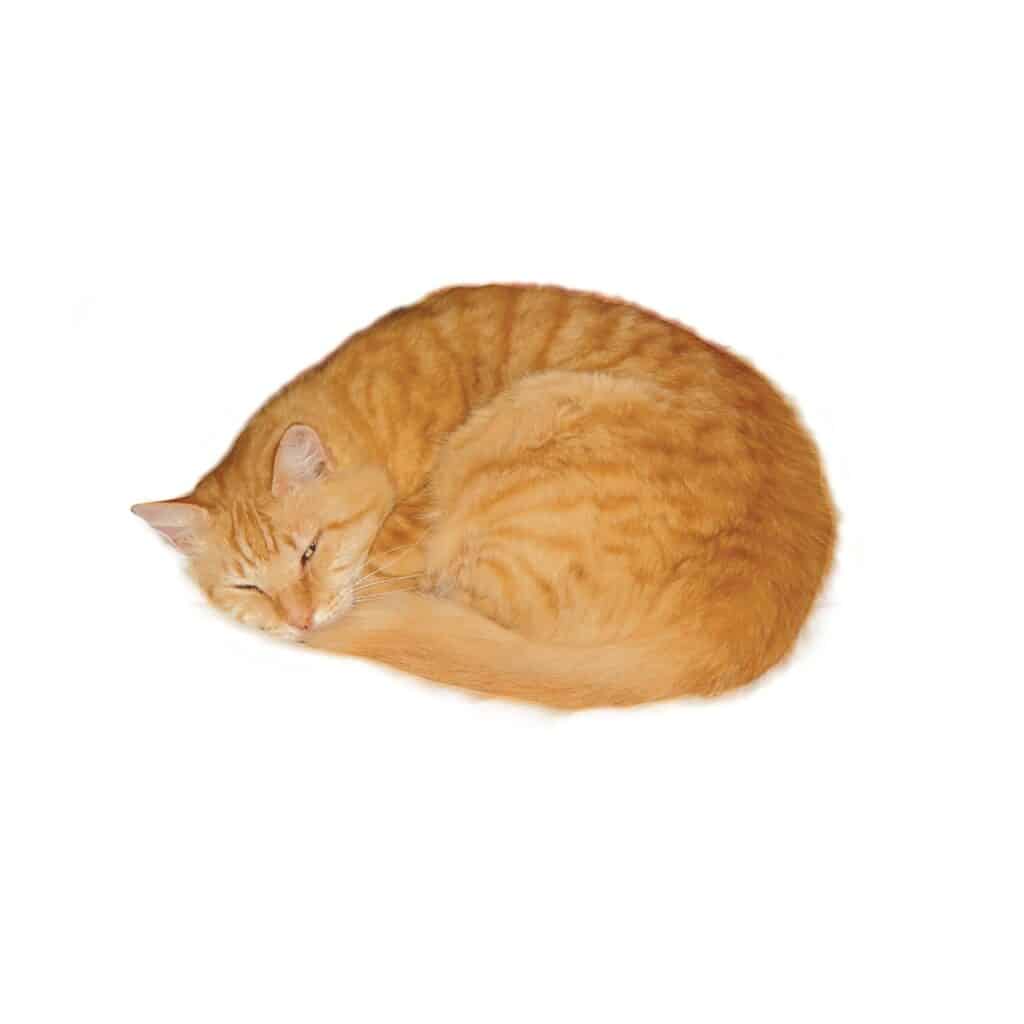
This is the most common position for cats to sleep. It is almost impossible not to run into a cat that doesn’t use this position.
Cats often curl up in a ball while sleeping or resting, which can indicate that they feel cozy and comfortable.
Cats like to curl up to stay warm and cozy during cold weather and feel protected. Most animals like to sleep in this position. You may have observed dogs doing the same if you have a dog.
It is also a position that lets cats fit in smaller spaces.
2. CATS STANDING UP ON THEIR HIND LEGS
![21+ CAT POSITIONS MEANING [WHILE SLEEPING OR AWAKE]](https://dorkycats.com/wp-content/uploads/2020/10/Cat-standing-on-hind-legs.jpg)
Some cats may stand on their hider legs to try to reach something higher than them. They may also raise their hind legs to intimidate other cats or animals. It is a bit of what bears do when challenged; they stand on their legs and become way taller. By doing this, they are trying to become scarier to others than they are.
If they are not trying to reach something and take this position, cats are not relaxed, they are either scaring someone off or they are afraid and looking for something.
3. LOAF POSITION
![21+ CAT POSITIONS MEANING [WHILE SLEEPING OR AWAKE]](https://dorkycats.com/wp-content/uploads/2020/10/cat-3059075_1280-1024x678.jpg)
Sometimes cats sit up in a sort of loaf; they fold their paws under them and stand there lounging, closing their eyes, or leaving their eyes open at times. In this position, cats are resting and chilling but without really sleeping. It is a way for cats to rest, keep alert, and watch the world.
If they stand in this position means they are relaxed and see no immediate danger. However, they are still ready to jump if needed.
Here are some ideas for cats beds to make cats comfortable in any position:










4. SIDE SLEEP POSITION
![21+ CAT POSITIONS MEANING [WHILE SLEEPING OR AWAKE]](https://dorkycats.com/wp-content/uploads/2020/10/cat-1058095_1280-1024x682.jpg)
I do not know about your cat, but my cat starts to sleep on his side only if he thinks that he is totally safe and that I or anybody else in the house is not about to jump on them. He has to be very relaxed and in a state of mind that tells him he can lower his guard.
When a cat sleeps on their side, it generally means they feel very relaxed and comfortable. This is a vulnerable position for a cat to be in, as it leaves their belly and vital organs exposed, so cats will only sleep in this position if they feel safe and secure in their environment.
Sleeping on their side also allows cats to completely let go of any muscle tension and fully stretch out their limbs, which can help them feel more rested and refreshed.
It’s worth noting that cats may not always sleep directly on their side but may instead sleep at an angle or with their legs slightly tucked in. Regardless of the exact position, if a cat sleeps in a relaxed and open posture, it generally means they feel comfortable and at ease in its surroundings.
5. FACE DOWN (FACEPLANT)

Sometimes cats put their paws on their face, especially when they are sleeping. I have observed my cat covering his face with his paws when I am petting him while sleeping. I thought from his gesture that he wanted to be left alone.
When a cat puts their face flat on the ground (also known as a “faceplant”), it can have a few different meanings depending on the context.
- Relaxation: Sometimes, a cat may put their face flat on the ground as a sign of relaxation. They may be taking a nap or just enjoying a moment of peace.
- Curiosity: Cats are naturally curious animals, and they may put their face flat on the ground to investigate something that has caught their interest. They may be trying to get a better look at a scent or object on the ground.
- Playfulness: Cats may also put their face flat on the ground during play. They may be getting ready to pounce on a toy or another cat or using this position to initiate play.
- Health issues: Sometimes, a cat may put their face flat on the ground due to a health issue. For example, they may be experiencing discomfort or pain in their mouth or teeth or may be having trouble breathing.
6. BELLY-UP POSITION

Cats can show you the belly in different circumstances. They may want to play and turn upside down, they are sleeping, and suddenly they start sleeping on their back and showing their belly.
Or they see you, and suddenly they get on the floor, showing their belly. In the last case, if they do, it is because they want to say hello; they are excited to see you.
If they show the belly while sleeping, they are completely in a deep sleep, and they are very relaxed and secure in the environment, and you do not think that something bad is about to happen. In this position, cats are totally exposed. Therefore if they do it, they really have trust in you and the environment.
7. ACROBATIC OR CONTORTIONIST SLEEP

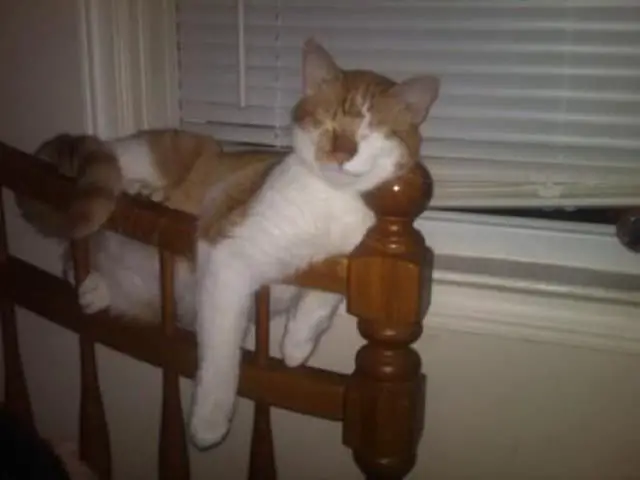
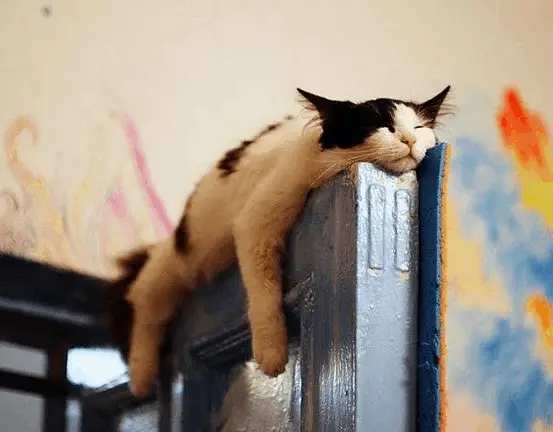
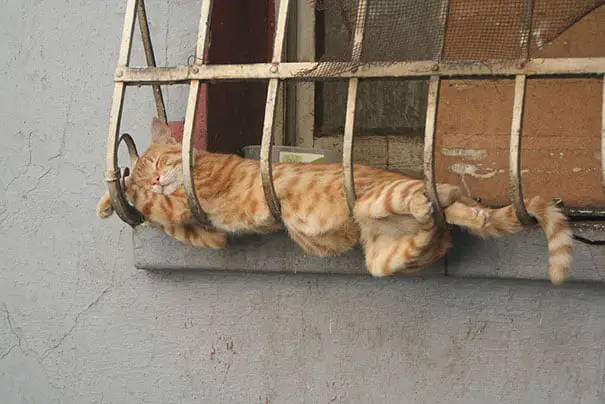
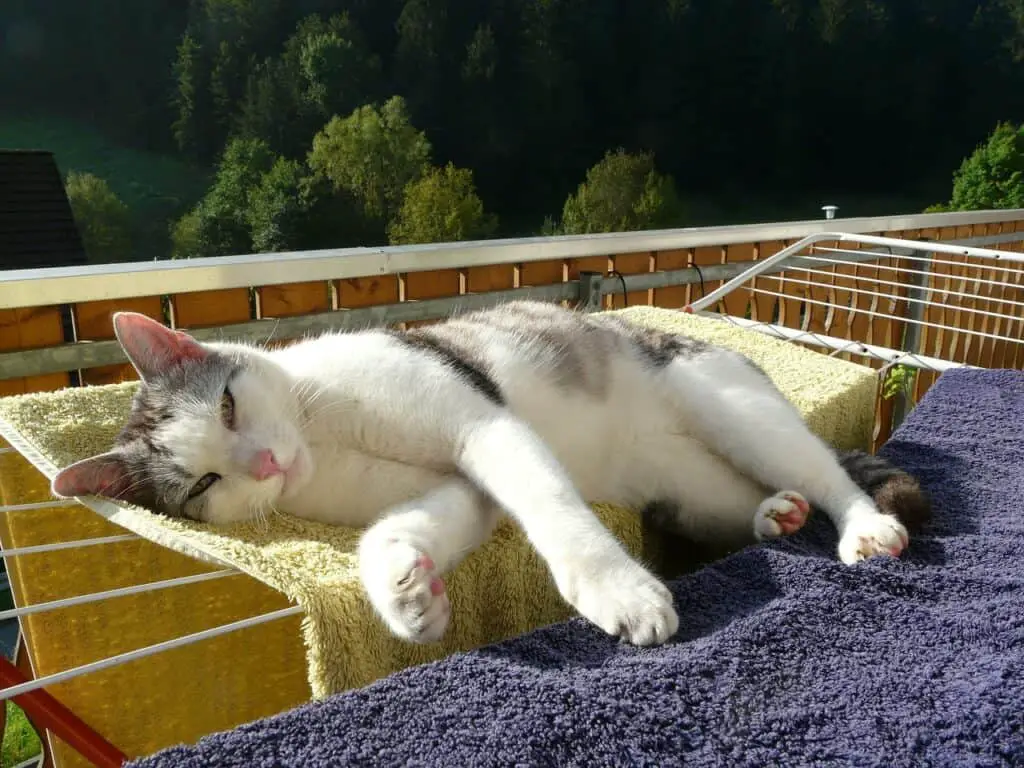
Cats are weird and unpredictable, which is why we like them; they can always surprise us. You can find this quality in cats even when they sleep, somehow, they can sleep on anything, and I mean anything.
It doesn’t matter how hard, cold, or unpleasant it is; they can still use it as a bed.
Cats have the gift of a very flexible and mobile body that allows them to be contortionists even in their sleep. Cats would sleep on anything they think are safe.
If they are standing in a higher position, they feel safe, but the safest places that are also high enough are not the most comfortable. So cats deal with it as they can.
If they sleep in any weird position because they want to feel safe, or suddenly they get tired, they suddenly sleep wherever they are.
9. AFRAID POSITION

This position is often a sign that a cat feels cautious or fearful. It may be accompanied by flattened ears, dilated pupils, and a lowered tail.
You may have seen your cat crouching down; try to make himself small, their eyes will be open very wide, with pupils fully dilated, the ears can be flattered back against the head, the tail is placed under them, or you will see it moving widely from one side to another. Cats may growl or meow as well.
Some cats may arch their back to seem taller and try to frighten someone else. When they do it, it is because they are afraid in the first place, not because they want to fight.
10. RELAXED POSITION
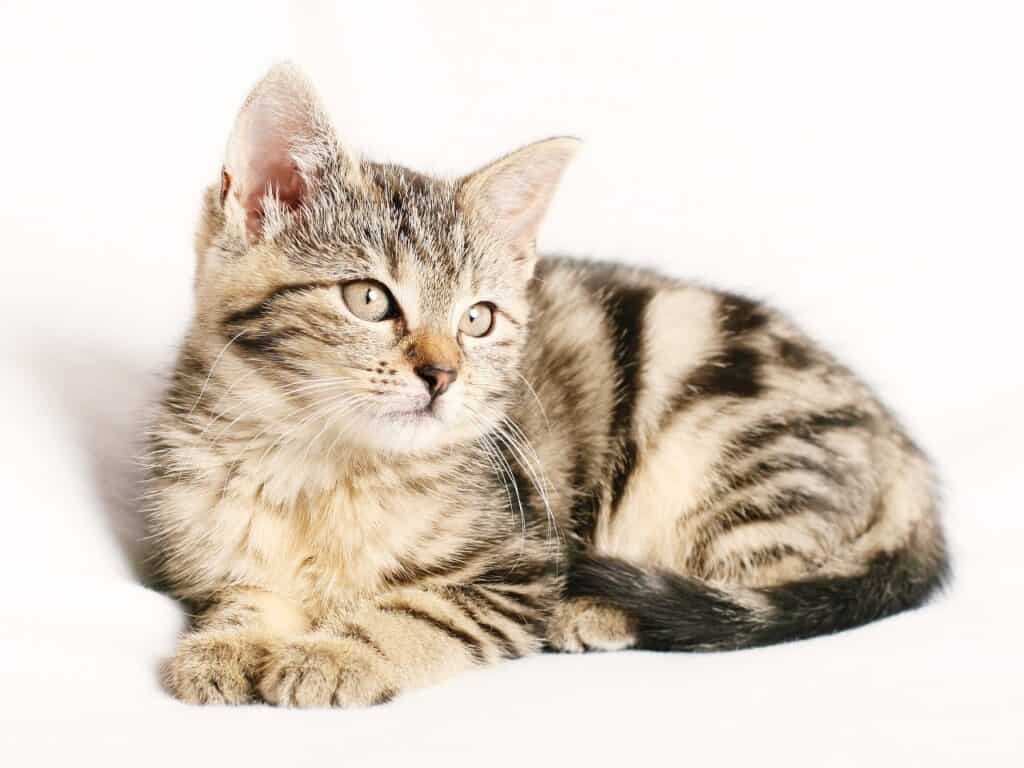
Cats may just sit and look around doing nothing; they show no sign of tension, the eyes are not wide dilated, the ears are normal, and the tail is not moving wildly or pointing up words. If they are relaxed, they may have their eyes half-closed, or they may slowly blink as well.
Cats may also relax by stretching their bodies.
11. FOCUSED OR POINTING POSITION

Cats are hunters, so you may find them stalking something or someone and focusing on them with all their attention.
Their eyes will be open with pupils narrowed; all their body is pointing or looking in the prey’s direction, the body can be lowered while walking, and they will try to stay low not to scare the prey.
Cats will also place their tail low, but you can see the end of the tail twitching from one side to another. When you see a cat behaving this way, you watch a cat hunting something.
12. ANXIOUS CAT POSITION

When a cat is afraid, their body language typically reflects this emotion. Some common signs of fear in cats include:
- Crouched body: A fearful cat may lower their body to the ground or crouch down in an attempt to appear smaller and less noticeable.
- Flattened ears: A cat’s ears may be pulled flat against its head when they are afraid.
- Dilated pupils: Fear can cause a cat’s pupils to become large and dilated, making their eyes appear wider than usual.
- Arched back: A cat may arch their back to make itself appear larger and more intimidating.
- Tail position: When a cat is afraid, it may tuck its tail tightly between its legs or hold it low and close to its body.
- Avoidance: A fearful cat may try to avoid eye contact or physical contact with people or other animals and may try to hide or retreat to a safe location.
13. ANGRY POSITION
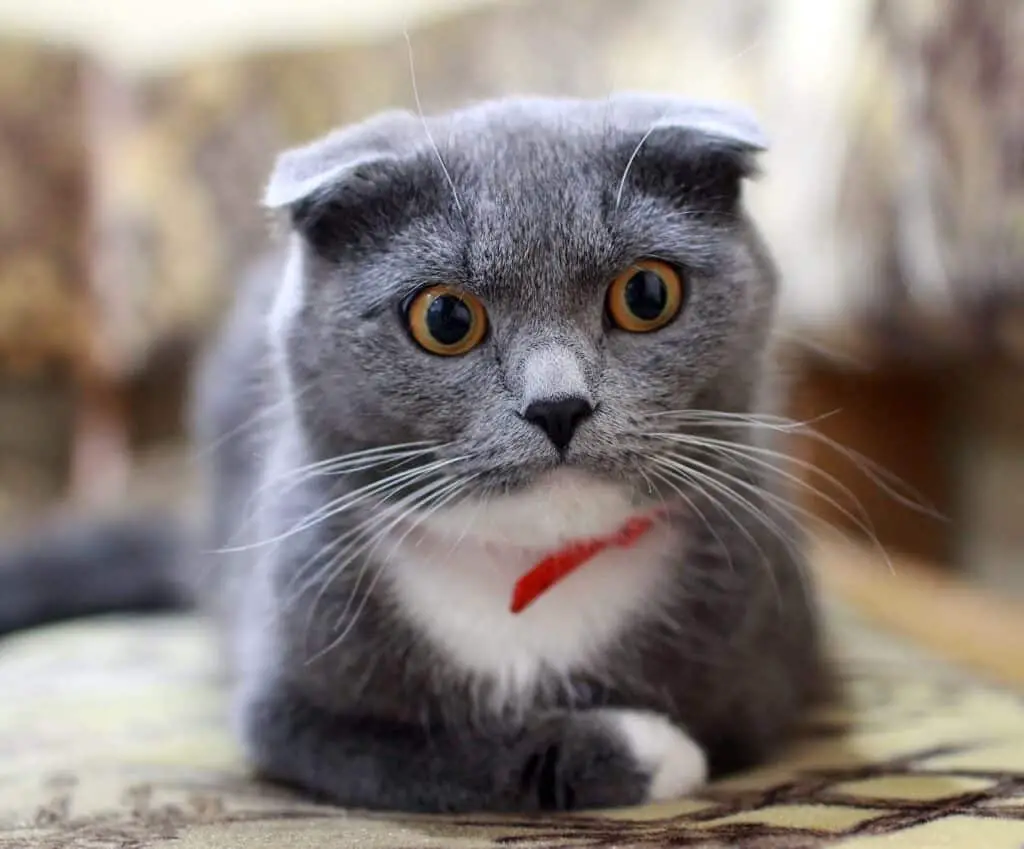
You can see if your cat is upset or angry because his ears will be pointing down, he will have big eyes, you can see in his face that he is not happy at all, they are going to be rigid, and so their tail will be rigid and unmoving, the tail can be rigid and straight or curled under their body.
When a cat is angry, their body language often reflects this emotion. Some common signs of anger or aggression in cats include:
- Stiff body posture: An angry cat may hold their body very still and tense, with their muscles visibly contracted.
- Ears flattened: A cat’s ears may be pulled flat against its head or facing backward when they are angry.
- Piloerection: An angry cat may puff up their fur, making it appear larger and more intimidating.
- Dilated pupils: Like fear, anger can cause a cat’s pupils to become large and dilated.
- Low growling or hissing: An angry cat may make low growling or hissing sounds to warn of potential threats.
- Raised tail: A cat may hold their tail high and erect when they are feeling aggressive or agitated.
- Swishing tail: An angry cat may also lash their tail repeatedly as a sign of agitation.
14. FRIENDLY POSITION
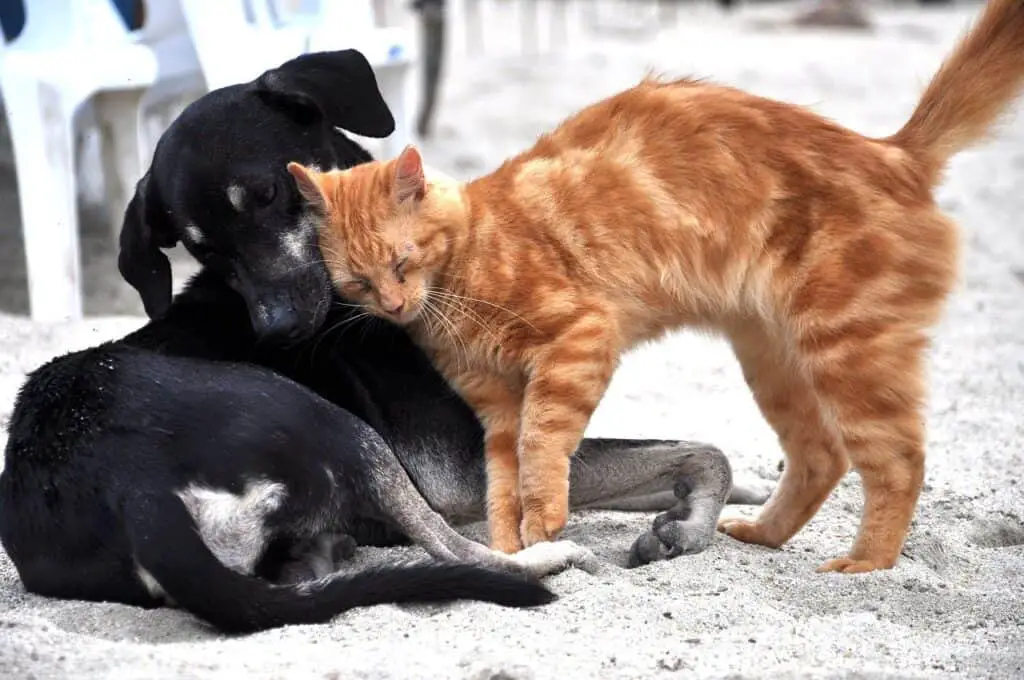
If your cat moves toward you with the tail pointing upwards and rubs against you, your cat is amiable and demonstrates affection.
There are several ways to tell if a cat is friendly and open to interaction. Here are some common signs of a friendly cat:
- Relaxed body posture: A friendly cat typically has a relaxed body posture.
- Ears facing forward: A cat interested in socializing typically has its ears facing forward and may even tilt its head to get a better look at you.
- Slow blinking: A friendly cat may make slow, deliberate blinks while looking at you. This is often interpreted as a sign of trust and affection.
- Purring: Cats will often purr when they are feeling happy and relaxed, so if a cat is purring while in your presence, it’s usually a good sign that they are feeling friendly and content.
- Rubbing against you: Cats often rub their bodies against people or objects they like to mark their territory and show affection.
- Rolling onto their back: A cat may roll onto their back in a relaxed and open posture when they are feeling friendly and comfortable. This is a sign that they trust you and are open to physical contact.
15. SPLOOTING POSITION
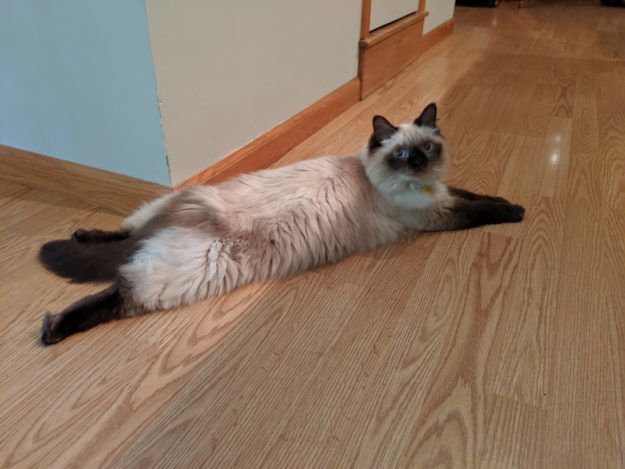
Sometimes cats would lie down with all their legs spread up and their body right on the floor.
The “splooting” position is a term that refers to a specific way that some cats (and dogs) sit or lie down. It’s not a technical term but rather a colloquial term that has become popular on social media.
In the splooting position, a cat typically lies down with one or both legs stretched out behind them.
While this position may look cute and amusing, it’s important to note that not all cats will assume it, and it’s not necessarily a sign of anything specific. Some cats may simply prefer to lie down this way because it’s comfortable for them, while others may never assume this position.
16. STRETCHED OUT ( WHILE SLEEPING)

Cats may also sleep with their body fully stretched out, either on their side or on their belly. This position allows them to fully relax their muscles and stretch their limbs.
17. TUCKED IN

Another position that cats may assume is to tuck their front paws under their chest while lying on their belly. This can create a compact, cozy posture that helps them feel safe and secure.
18. BACK SLEEPING
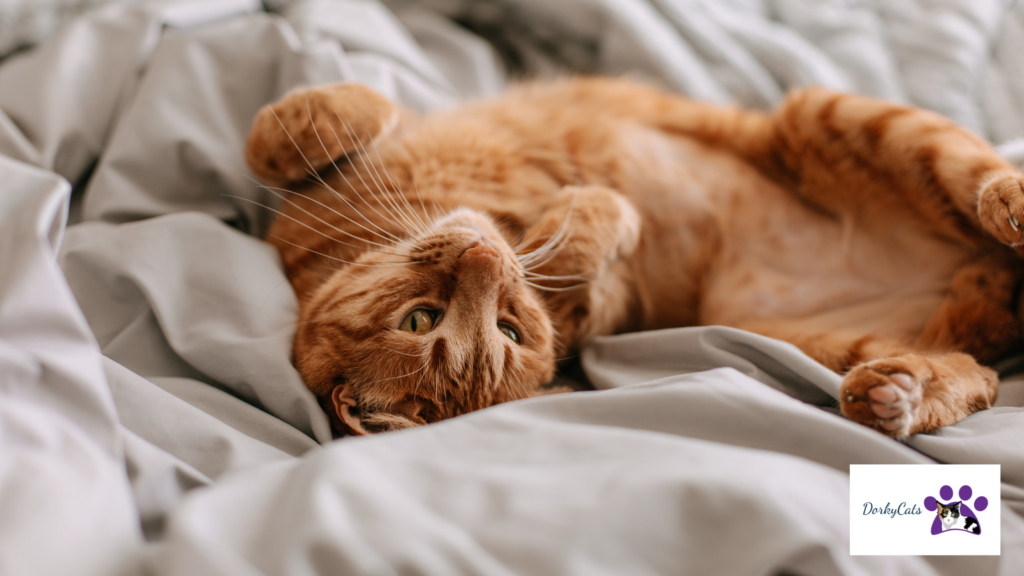
Some cats may even sleep on their backs, with their paws in the air. This position can indicate that the cat feels very relaxed and comfortable. Still, it can also be a vulnerable position that they may only assume in a safe and secure environment.
19. HALF-ASLEEP
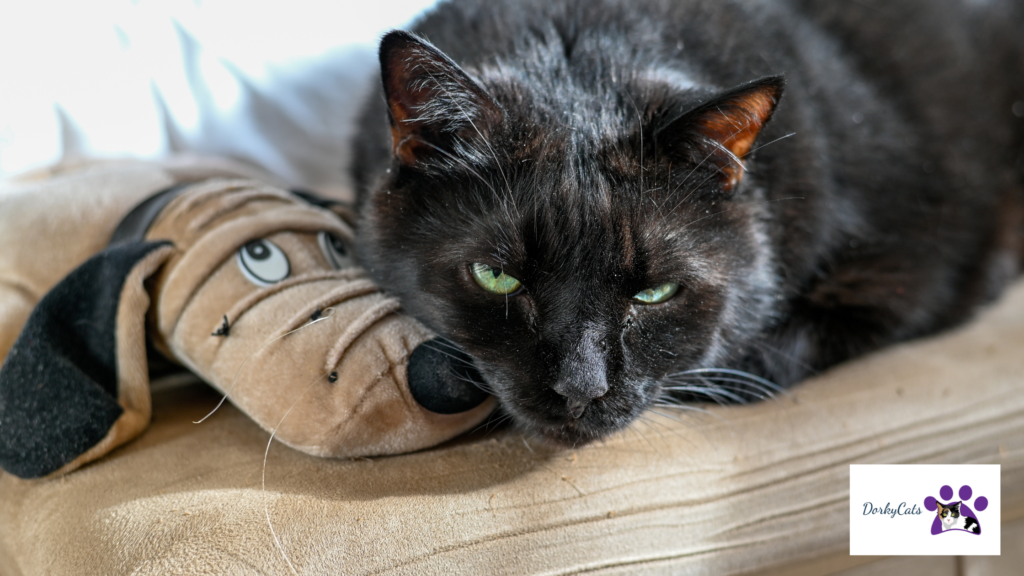
Cats may also assume a half-asleep position, where they are not fully asleep but are still very relaxed. In this position, the cat may lie with their eyes half-open and may be more easily startled or responsive to stimuli.
WHAT ARE THE CAT SLEEPING POSITIONS WITH THE OWNER?
When sleeping with their owner, cats may assume a few different positions, depending on their personality and level of comfort with the person. Here are a few common positions:
SNUGGLE UP
Some cats may prefer to snuggle up close to their owner while they sleep, either curled up in a ball or stretched out alongside them. This can indicate that the cat feels safe and secure with the person and enjoys their company.
ON THE OWNER’S FEET
Cats may also sleep on their owner’s feet or legs, which can provide a sense of warmth and security. In this position, the cat may be more likely to wake up if the person moves or gets up.
ON THE PILLOW
Some cats may even sleep on their owner’s pillow, either next to their head or on top of it. This can signify that the cat feels very close and bonded with the person and enjoys being close to their scent.
Not all cats will want to sleep with their owners, and some may prefer to sleep in a separate area of the house.
WHAT ARE THE CAT SLEEPING POSITIONS WHEN SICK?
When sick, cats may assume different sleeping positions depending on their symptoms and feelings. Here are a few common positions that cats may assume when they are not feeling well:
- Cuddled up: Sick cats may prefer to cuddle up in a tight ball, tucking their head and tail in close to their body. This can help them feel more secure and comfortable while they rest.
- Flat on their side: Cats may also lie flat on their side while sick, with their legs stretched out and their head resting on the ground. This can indicate that they feel very weak and have difficulty moving around.
- In their bed: Sick cats may also spend more time than usual in their bed or another comfortable sleeping spot. They may tuck themselves in tightly and avoid moving around too much.
- Lying with head up: In some cases, cats may lie with their head up while sick, indicating that they may be experiencing breathing difficulties or congestion.
FREQUENTLY ASKED QUESTIONS
Why does my cat lay flat on her stomach?
Cats can lay on their stomach because they want to cool off their body temperature, they want to chill, or they want to rest without really sleeping so they can stay alert.
Why is my cat lying on the floor?
Cats may like to lay on floors because floors are much cooler; you can see it, especially in summer when cats are all over the floors. They also may like the fact that floors are harder. For some reason, cats like harder surfaces, my cats have 3 or 4 beds, and they still sleep on the floor.
Is Splooting bad for dogs?
Not necessarily; cats do that on their terms; they need to stretch and cool down. However, if you see that your cat is doing it too much or starts doing it suddenly, you can check him out to see if everything is ok.
Why does my cat sit in weird positions?
Cats are weird and famous for sitting and sleeping in the weirdest positions; you never know how your cat will position himself. Therefore a certain dose of “weird” is normal for cats. If he insists on being weird only in particular ways, maybe you can check if he has a body part problem.
Why does my cat sit like a sphinx?
This is most probably the loaf position. If your cat takes that position, he is actually relaxing and trying to rest without lowering his guard, or at least giving that impression to outside people and animals; in that position, if something happens, they are ready to jump and run.

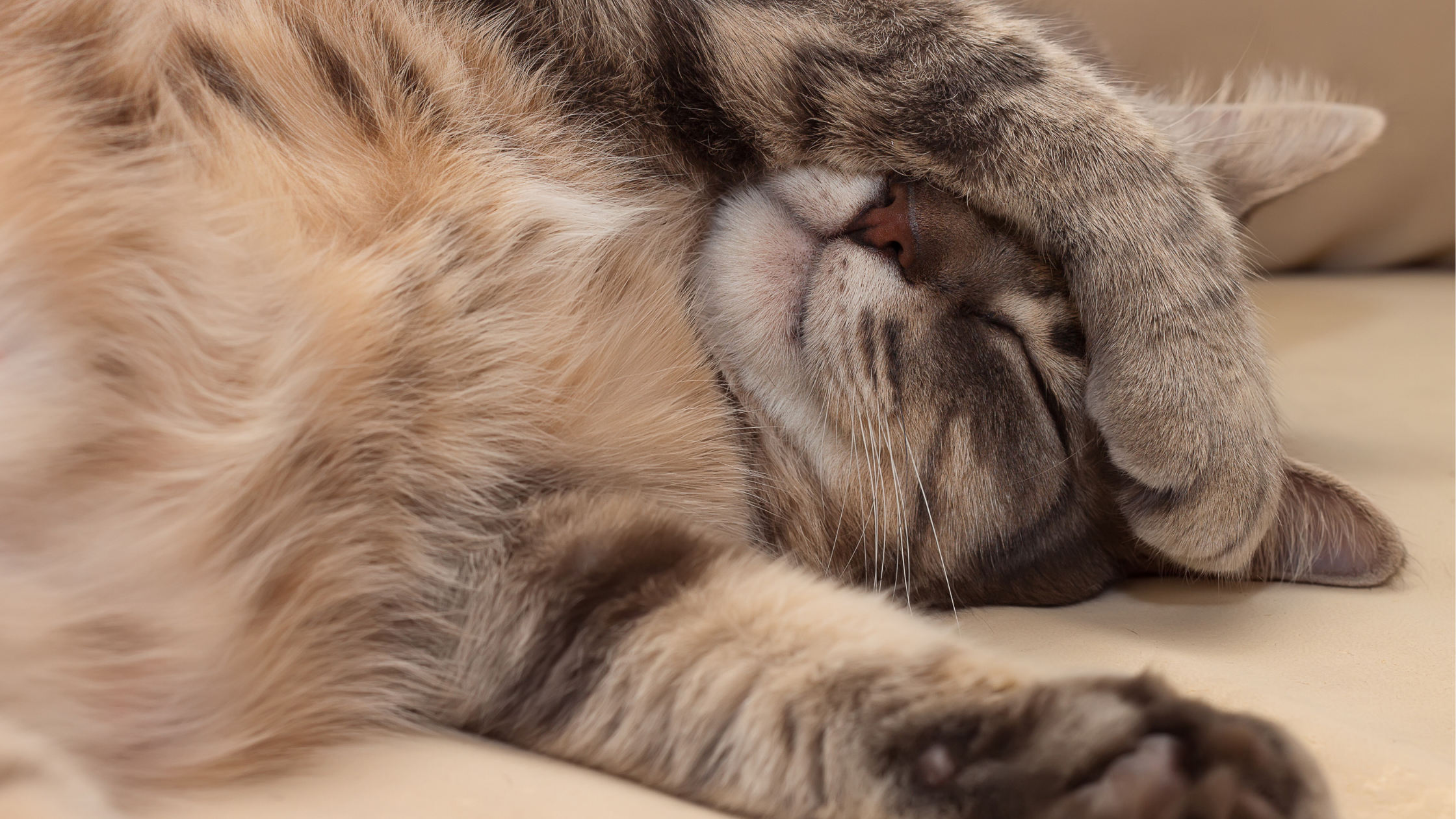

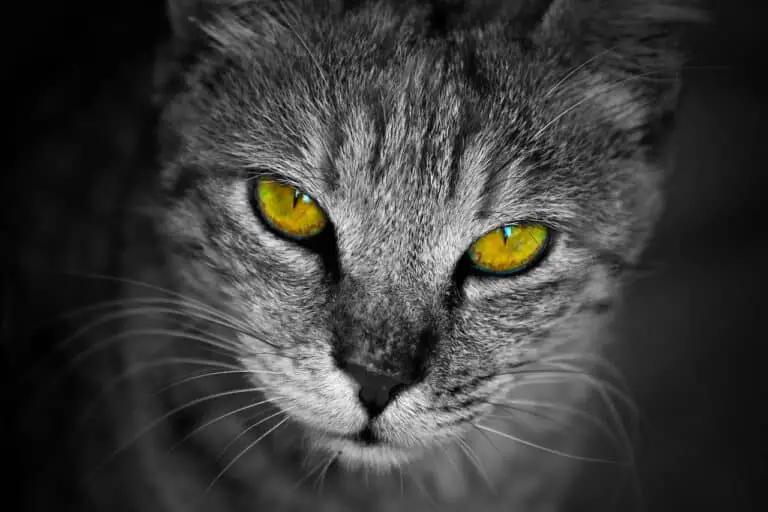
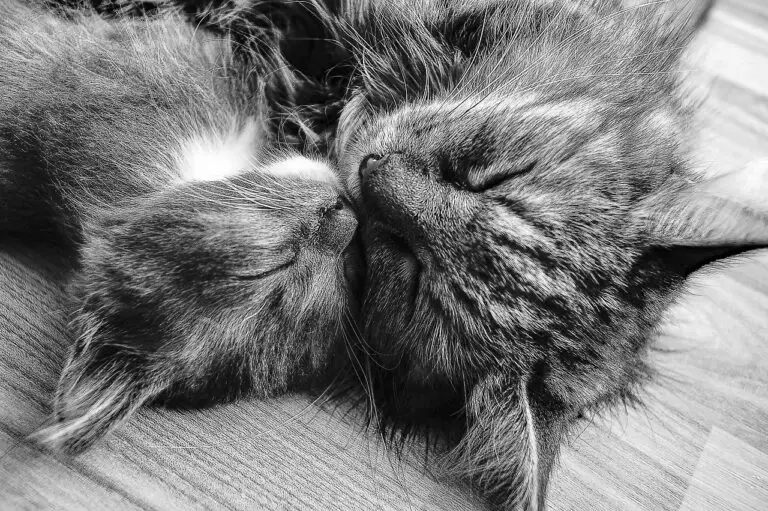


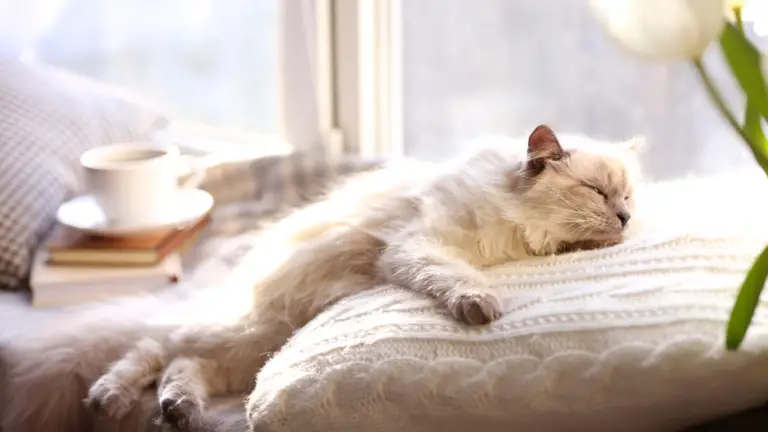
This is a great post! I’m a cat lover and this post has helped me understand the different positions cats take. Thanks for sharing!